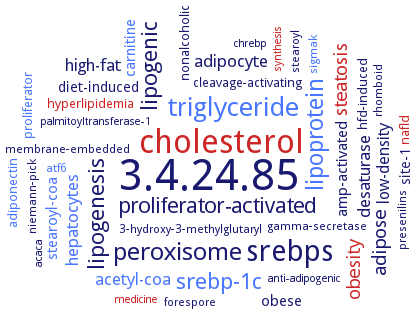3.4.24.85: S2P endopeptidase
This is an abbreviated version!
For detailed information about S2P endopeptidase, go to the full flat file.

Word Map on EC 3.4.24.85 
-
3.4.24.85
-
cholesterol
-
srebps
-
triglyceride
-
peroxisome
-
lipoprotein
-
lipogenesis
-
srebp-1c
-
lipogenic
-
proliferator-activated
-
steatosis
-
adipose
-
obesity
-
acetyl-coa
-
high-fat
-
adipocyte
-
desaturase
-
hepatocytes
-
low-density
-
carnitine
-
obese
-
stearoyl-coa
-
amp-activated
-
diet-induced
-
site-1
-
proliferator
-
hfd-induced
-
cleavage-activating
-
nonalcoholic
-
adiponectin
-
hyperlipidemia
-
nafld
-
stearoyl
-
forespore
-
presenilins
-
niemann-pick
-
3-hydroxy-3-methylglutaryl
-
sigmak
-
gamma-secretase
-
membrane-embedded
-
atf6
-
rhomboid
-
anti-adipogenic
-
medicine
-
chrebp
-
acaca
-
synthesis
-
palmitoyltransferase-1
- 3.4.24.85
- cholesterol
-
srebps
- triglyceride
- peroxisome
- lipoprotein
-
lipogenesis
- srebp-1c
-
lipogenic
-
proliferator-activated
- steatosis
- adipose
- obesity
- acetyl-coa
-
high-fat
- adipocyte
-
desaturase
- hepatocytes
-
low-density
- carnitine
-
obese
- stearoyl-coa
-
amp-activated
-
diet-induced
-
site-1
- proliferator
-
hfd-induced
-
cleavage-activating
-
nonalcoholic
- adiponectin
- hyperlipidemia
- nafld
-
stearoyl
-
forespore
-
presenilins
-
niemann-pick
-
3-hydroxy-3-methylglutaryl
- sigmak
- gamma-secretase
-
membrane-embedded
- atf6
- rhomboid
-
anti-adipogenic
- medicine
-
chrebp
- acaca
- synthesis
-
palmitoyltransferase-1
Reaction
Cleaves several transcription factors that are type-2 transmembrane proteins within membrane-spanning domains. Known substrates include sterol regulatory element-binding protein (SREBP) -1, SREBP-2 and forms of the transcriptional activator ATF6. SREBP-2 is cleaved at the site DRSR_ILL_483-/-CVLTFLCLSFNPLTSLLQWGGA, in which the membrane-spanning segment is underlined. The residues NP (bold), 11 residues distal to the site of cleavage in the membrane-spanning domain, are important for cleavage by S2P endopeptidase. Replacement of either of these residues does not prevent cleavage, but there is no cleavage if both of these residues are replaced. =
Synonyms
EcfE, Eep, HurP, I-CLiP, intramembrane-cleaving protease, MEROPS:M50, MmpA, MucP, proteinase, sterol regulatory element-binding protein, RasP, RseP, Rv2869c, S2P, S2P protease, site-1 protease, site-2 metalloprotease, site-2 protease, site-2-protease, sll0528, Slr0643, Slr1821, SPOIVFB, Sre2, SREBP cleavage activity, SREBP cysteine proteinase, SREBP proteinase, SREBP-1 proteinase, SREBP-2 proteinase, sterol regulatory element binding protein, sterol regulatory element binding protein-2 proteinase, sterol regulatory element-binding proteinase, sterol-regulated protease, Stp1, YaeL, YluC


 results (
results ( results (
results ( top
top






